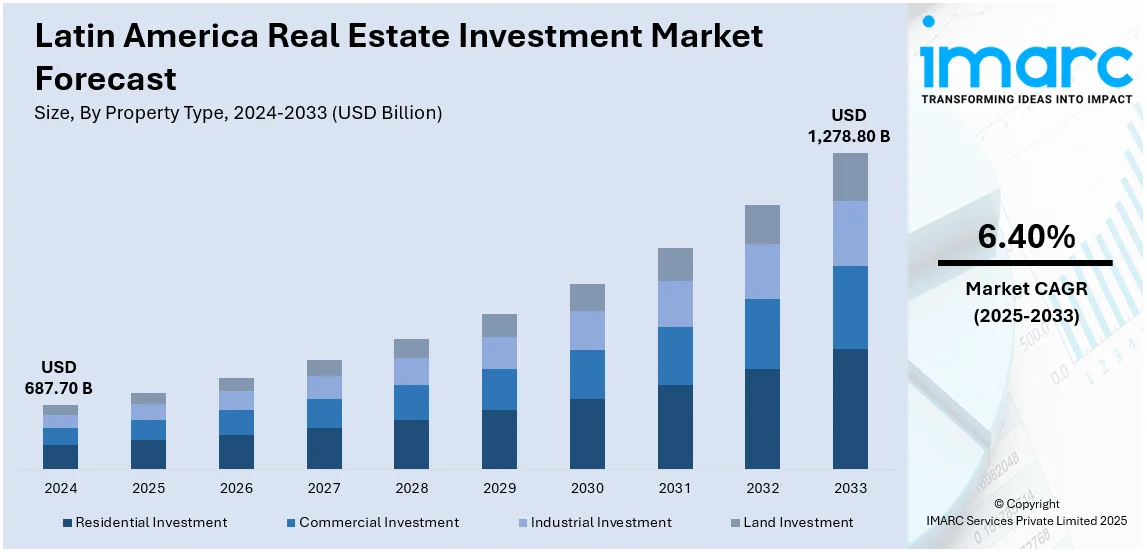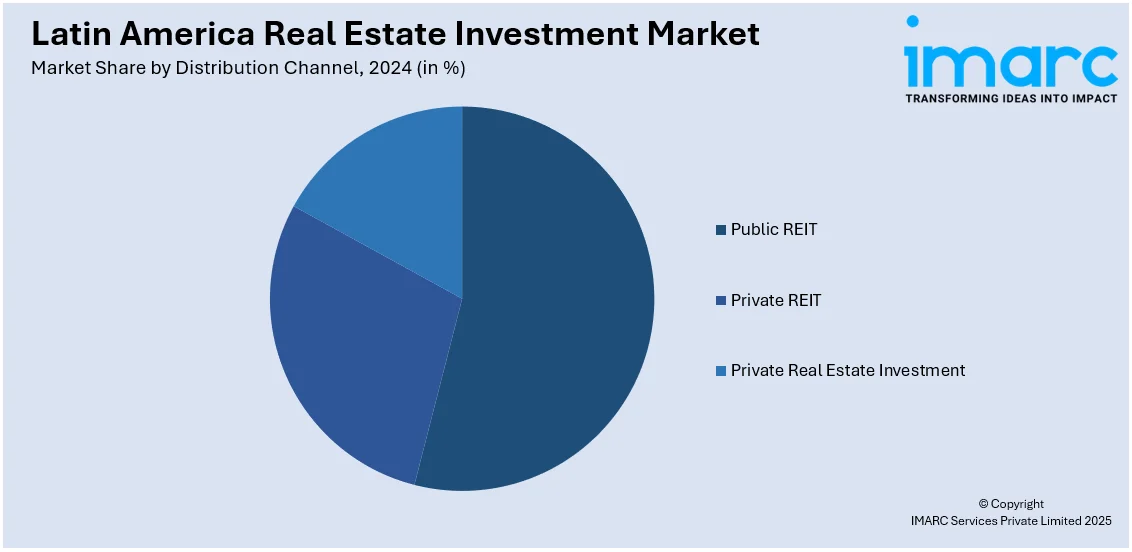
Latin America Real Estate Investment Market Size, Share, Trends and Forecast by Property Type, Distribution Channel, Purpose, and Country, 2025-2033
Latin America Real Estate Investment Market Overview:
The Latin America real estate investment market size reached USD 687.70 Billion in 2024. Looking forward, IMARC Group expects the market to reach USD 1,278.80 Billion by 2033, exhibiting a growth rate (CAGR) of 6.40% during 2025-2033. The Latin America real estate investment market share is primarily driven by expanding middle class population, rapid economic growth and urbanization, and increasing foreign direct investments and global interest, significant infrastructure development and public-private partnerships, and regulatory reforms coupled with investment incentives enhancing the investment climate across the region.
|
Report Attribute
|
Key Statistics
|
|---|---|
|
Base Year
|
2024 |
|
Forecast Years
|
2025-2033
|
|
Historical Years
|
2019-2024
|
| Market Size in 2024 | USD 687.70 Billion |
| Market Forecast in 2033 | USD 1,278.80 Billion |
| Market Growth Rate 2025-2033 | 6.40% |
Latin America Real Estate Investment Market Trends:
Growing Middle Class Population and Rising Consumer Demand
The expanding middle class population is fueling the Latin America real estate investment market growth. As household income continues to increase and families are becoming more financially secure, the demand for residential properties is growing, especially in the affordable and mid-range housing sectors. The change in population demographics is leading to an increased number of individuals being able to attain the dream of owning a home. The growing demand for improved housing choices and government efforts to encourage homeownership with financial aid and easier loan access are benefiting the real estate sector. Moreover, the increasing middle-class population is also fueling the need for commercial properties such as retail and entertainment areas. Investors are noticing this pattern and are investing in residential and commercial projects aimed at the middle class, anticipating high profits from the expanding market.

Growing Industrial Real Estate Investment
Growing industrial real estate investment is significantly driving the Latin America real estate investment market forecast. Rising e-commerce demand is increasing the need for warehouses and distribution centers, attracting substantial investments in logistics infrastructure. Nearshoring trends are compelling companies to relocate production closer, catalyzing demand for industrial properties in key locations. Reflecting this trend, Thor Urbana expanded its industrial portfolio in Mexico in July 2024, acquiring nine properties in Saltillo and Ramos Arizpe, Coahuila, with over 1.6 Billion square feet of leasable space. This aligns with the region’s 27% FDI growth in 2023, surpassing US$36 billion, highlighting growing investor interest. Infrastructure development, automation, and sustainability initiatives are further enhancing industrial property values. Institutional investors and REITs are increasing allocations, recognizing stable rental yields. The rise of last-mile delivery services is driving demand for strategically located urban warehouses.
Infrastructure Development and Public-Private Partnerships
The advancement of infrastructure is crucial for stimulating real estate investments in Latin America. Local governments are investing heavily in transportation, utilities, and telecommunications to enhance the attractiveness of real estate projects. Public-private partnerships (PPPs) are rising in prominence, where private investors collaborate with governments to build essential infrastructure such as roads, airports, and public transit systems. These efforts improve urban settings by increasing their accessibility and livability, while also generating growth prospects in areas that were previously underdeveloped. Improved transportation links can significantly boost the value of real estate in areas that were once overlooked, making them more attractive to investors both locally and internationally. The partnership between construction projects and property investments is favorably impacting the Latin America real estate investment market outlook, as many investors seek to capitalize on improved connectivity and public facilities.
Latin America Real Estate Investment Market Segmentation:
IMARC Group provides an analysis of the key trends in each segment of the market, along with forecasts at the country level for 2025-2033. Our report has categorized the market based on property type, distribution channel, and purpose.
Property Type Insights:
- Residential Investment
- Commercial Investment
- Office Space
- Retail Space
- Leisure Space
- Others
- Industrial Investment
- Manufacturing Plants
- Warehouse/Distribution
- Others
- Land Investment
The report has provided a detailed breakup and analysis of the market based on the property type. This includes residential investment, commercial investment (office space, retail space, leisure space, others), industrial investment (manufacturing plants, warehouse/distribution, others), and land investment.
Distribution Channel Insights:

- Public REIT
- Private REIT
- Private Real Estate Investment
A detailed breakup and analysis of the market based on the distribution channel have also been provided in the report. This includes public REIT, private REIT, and private real estate investment.
Purpose Insights:
- Sales
- Rental
A detailed breakup and analysis of the market based on the purpose have also been provided in the report. This includes sales and rental.
Regional Insights:
- Brazil
- Mexico
- Argentina
- Colombia
- Chile
- Peru
- Others
The report has also provided a comprehensive analysis of all the major regional markets, which include Brazil, Mexico, Argentina, Colombia, Chile, Peru, and others.
Competitive Landscape:
The market research report has also provided a comprehensive analysis of the competitive landscape. Competitive analysis such as market structure, key player positioning, top winning strategies, competitive dashboard, and company evaluation quadrant has been covered in the report. Also, detailed profiles of all major companies have been provided.
Latin America Real Estate Investment Market News:
- In May 2024, Hines announced the expansion of its Private Wealth Solutions into Latin America through a partnership with iCapital. This move allows Latin American investors to access a diversified global portfolio valued at $4.14 billion, focusing on industrial and living sectors. The initiative strengthens Hines' presence in the Latin American real estate investment market, enhancing global investment opportunities for local investors.
- In May 2024, Patria Investments completed all necessary steps to finalize the transfer of Credit Suisse's Brazilian real estate funds, valued at approximately $2.4 billion. This transaction positions Patria as a leading real estate manager in Brazil and across Latin America, expanding its real estate assets to over $6 billion. This development strengthens Patria’s presence in key markets such as Brazil, Chile, and Colombia, further improving investment opportunities in the Latin American real estate sector.
Latin America Real Estate Investment Market Report Coverage:
| Report Features | Details |
|---|---|
| Base Year of the Analysis | 2024 |
| Historical Period | 2019-2024 |
| Forecast Period | 2025-2033 |
| Units | Billion USD |
| Scope of the Report |
Exploration of Historical Trends and Market Outlook, Industry Catalysts and Challenges, Segment-Wise Historical and Future Market Assessment:
|
| Property Types Covered |
|
| Distribution Channels Covered | Public REIT, Private REIT, Private Real Estate Investment |
| Purposes Covered | Sales, Rental |
| Regions Covered | Brazil, Mexico, Argentina, Colombia, Chile, Peru, Others |
| Customization Scope | 10% Free Customization |
| Post-Sale Analyst Support | 10-12 Weeks |
| Delivery Format | PDF and Excel through Email (We can also provide the editable version of the report in PPT/Word format on special request) |
Key Questions Answered in This Report:
- How has the Latin America real estate investment market performed so far and how will it perform in the coming years?
- What is the breakup of the Latin America real estate investment market on the basis of property type?
- What is the breakup of the Latin America real estate investment market on the basis of distribution channel?
- What is the breakup of the Latin America real estate investment market on the basis of purpose?
- What are the various stages in the value chain of the Latin America real estate investment market?
- What are the key driving factors and challenges in the Latin America real estate investment market?
- What is the structure of the Latin America real estate investment market and who are the key players?
- What is the degree of competition in the Latin America real estate investment market?
Key Benefits for Stakeholders:
- IMARC’s industry report offers a comprehensive quantitative analysis of various market segments, historical and current market trends, market forecasts, and dynamics of the Latin America real estate investment market from 2019-2033.
- The research report provides the latest information on the market drivers, challenges, and opportunities in the Latin America real estate investment market.
- Porter's five forces analysis assist stakeholders in assessing the impact of new entrants, competitive rivalry, supplier power, buyer power, and the threat of substitution. It helps stakeholders to analyze the level of competition within the Latin America real estate investment industry and its attractiveness.
- Competitive landscape allows stakeholders to understand their competitive environment and provides an insight into the current positions of key players in the market.
Need more help?
- Speak to our experienced analysts for insights on the current market scenarios.
- Include additional segments and countries to customize the report as per your requirement.
- Gain an unparalleled competitive advantage in your domain by understanding how to utilize the report and positively impacting your operations and revenue.
- For further assistance, please connect with our analysts.
 Inquire Before Buying
Inquire Before Buying
 Speak to an Analyst
Speak to an Analyst
 Request Brochure
Request Brochure
 Request Customization
Request Customization




.webp)




.webp)












